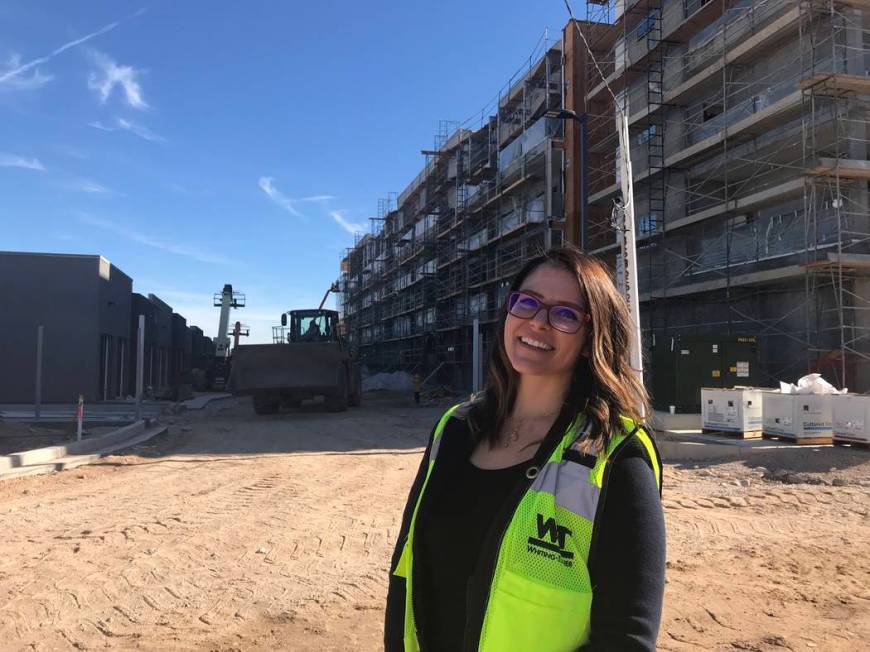Multifamily developer building green

A multifamily developer is raising a project with energy-efficiency in mind and bringing in 21st century technology.
Tru Development Co. is constructing the 210-unit Kaktus Life I apartment project at 10650 Dean Martin Drive in the Southern Highlands area with such attributes as low-flow showers, high-efficiency HVAC units, additional insulation and a solar array that is pegged to handle 5 percent of the energy load of the apartment community. Also, the developer is working to implement smart-home technology into the future luxury apartment building, which is set to have 21,600 square feet of retail space.
Kelly Kwasniewski, development logistics at Tru Development Co., said the company is seeking silver Leadership in Energy and Environmental Design certification on its project.
According to a Amanda Komar, media and communications specialist for the U.S. Green Building Council, as of mid-December, there there were only 12 multifamily projects in Nevada that have achieved LEED certification.
On the nonresidential side overall, some 231 projects have achieved certification.
The project is set to offer future tenants a connected experience.
“Each unit is going to have smart-apartment technology already built into it,” Kwasniewski said. “The tenant can opt out. They don’t necessarily have to use the smart-apartment technology because all the switches and everything will work without it.”
Those who opt-in to the smart tech will benefit from items such as having the lights turn on upon entry into their unit, as everything is on a sensor. All of the units have appliances that are equipped with Bluetooth connectivity.
Tru Development partnered with Portland, Oregon-based Iotas on the smart-home technology.
Rental rates have not been released for the project, but Kwasniewski said they’re competitive. The valley’s average for Class A multifamily product was $1,215 per month as of mid-November, according to research from CoStar, which was up from $1,100 a year earlier for the same product type.
Leadership at Tru Development drew inspiration from the Southern California market on the project, which is pegged to have one-bedroom (679-851 square feet) and two-bedroom (1,008-1,191 square feet) options.
“The owner of my company draws a lot of his inspiration from the Southern California market,” Kwasniewski said. “Walking into this, he really wanted to create a zero-carbon footprint environment.”
Kwasniewski said that “with that inspiration of a zero-carbon footprint environment and looking at renewable energy and kind of seeing how California is doing it and bringing that here, we had some cost obstacles. Getting past those obstacles — not being able to fully create the zero-carbon footprint environment — we were able actually to just capture building it in specs to meet LEED certification.”
Pushing forward on such efforts will capture some cost savings.
“Operational costs, year over year, we’ll be saving on water, gas, electricity, in all of those areas on the project as a whole,” she said.
Overhead operational costs are expected to be slashed by 37.5 percent, Kwasniewski said.
If the Kaktus Life project achieves LEED certification, there is a savings through a green building tax abatement program administered by the Nevada Governor’s Office of Energy. Kwasniewski expects the Kaktus Life project to see a 25 percent reduction on property taxes each year for a period of seven years if certified.
Part of the Kaktus Life project are several solar panels on its carports. Overall, the system is equal to 80-kilowatt hours.
A local expert said that bringing solar into a new multifamily project is not common in the Las Vegas Valley.
“We have the sunlight to go for it, but I have not seen any or many new projects that come out of the ground that utilize solar,” said Taylor Sims, multifamily director at Cushman & Wakefield’s Las Vegas office.
Sims said that tenants are paying for their own electricity, and developers would have to be using a lot of energy in common areas for them to have it make sense to integrate solar into a project.
“You get a five- to six-story project that has elevators and a big central area and air-conditioning bills,” Sims said. “Those are the kinds of things that really promote the use of solar in new developments. It’s not been prevalent out here, but I feel like it will be.”
Sims said he has heard of solar projects being considered for existing multifamily buildings.
“I’ve heard of guys considering putting solar on existing projects because of the ability to lower expenses and capitalize,” Sims said.
For Tru Development, the company is planning to break ground on a project near Buffalo Drive and the 215 Beltway in the southwest part of town. Again, the company is seeking LEED certification on its planned 614-unit multifamily project, which will have 5,000 square feet of retail.
That project is set to break ground in the spring.